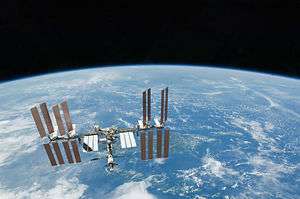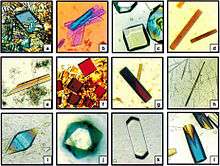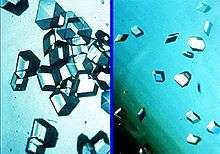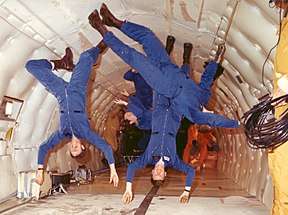Micro-g environment
The term micro-g environment (also μg, often referred to by the term microgravity) is more or less synonymous with the terms weightlessness and zero-g, but with an emphasis on the fact that g-forces are never exactly zero—just very small (on the ISS, for example, the small g-forces come from tidal effects, gravity from objects other than the Earth, such as astronauts, the spacecraft, and the Sun, and, occasionally, air resistance).[1][2] The symbol for microgravity, μg, was used on the insignias of Space Shuttle flights STS-87 and STS-107, because these flights were devoted to microgravity research in low Earth orbit.

Absence of gravity
A "stationary" micro-g environment[3] would require travelling far enough into deep space so as to reduce the effect of gravity by attenuation to almost zero. This is simple in conception but requires travelling a very large distance, rendering it highly impractical. For example, to reduce the gravity of the Earth by a factor of one million, one needs to be at a distance of 6 million kilometres from the Earth, but to reduce the gravity of the Sun to this amount, one has to be at a distance of 3.7 billion kilometres. (On Earth the gravity due to the rest of the Milky Way is already attenuated by a factor greater than one million, so we do not need to move away further from its center). Thus it is not impossible, but it has only been achieved so far by four interstellar probes (Voyager 1 and 2 of the Voyager program, and Pioneer 10 and 11 of the Pioneer program) and they did not return to Earth. If travel at the speed of light were possible for a spacecraft, it would take roughly three and a half hours to reach this micro-gravity environment (a region of space where the acceleration due to gravity is one-millionth of that experienced on the Earth's surface). To reduce the gravity to one-thousandth of that on Earth's surface, one needs to be at a distance of 200,000 km.
| Location | Gravity due to | Total | ||
|---|---|---|---|---|
| Earth | Sun | rest of Milky Way | ||
| Earth's surface | 9.81 m/s2 | 6 mm/s2 | 200 pm/s2 = 6 mm/s/yr | 9.81 m/s2 |
| Low Earth orbit | 9 m/s2 | 6 mm/s2 | 200 pm/s2 | 9 m/s2 |
| 200,000 km from Earth | 10 mm/s2 | 6 mm/s2 | 200 pm/s2 | up to 12 mm/s2 |
| 6×106 km from Earth | 10 μm/s2 | 6 mm/s2 | 200 pm/s2 | 6 mm/s2 |
| 3.7×109 km from Earth | 29 pm/s2 | 10 μm/s2 | 200 pm/s2 | 10 μm/s2 |
| Voyager 1 (17×109 km from Earth) | 1 pm/s2 | 500 nm/s2 | 200 pm/s2 | 500 nm/s2 |
| 0.1 light-year from Earth | 400 am/s2 | 200 pm/s2 | 200 pm/s2 | up to 400 pm/s2 |
At a distance relatively close to Earth (less than 3000 km), gravity is only slightly reduced. As an object orbits a body such as the Earth, gravity is still attracting objects towards the Earth and the object is accelerated downward at almost 1g. Because the objects are typically moving laterally with respect to the surface at such immense speeds, the object will not lose altitude because of the curvature of the Earth. When viewed from an orbiting observer, other close objects in space appear to be floating because everything is being pulled towards Earth at the same speed, but also moving forward as the Earth's surface "falls" away below. All these objects are in free fall, not zero gravity.
Compare the gravitational potential at some of these locations.
Free fall
What remains is a micro-g environment moving in free fall, i.e. there are no forces other than gravity acting on the people or objects in this environment. To prevent air drag making the free fall less perfect, objects and people can free-fall in a capsule that itself, while not necessarily in free fall, is accelerated as in free fall. This can be done by applying a force to compensate for air drag. Alternatively free fall can be carried out in space, or in a vacuum tower or shaft.
Two cases can be distinguished: Temporary micro-g, where after some time the Earth's surface is or would be reached, and indefinite micro-g.
A temporary micro-g environment exists in a drop tube (in a tower or shaft), a sub-orbital spaceflight, e.g. with a sounding rocket, and in an airplane such as used by NASA's Reduced Gravity Research Program, aka the Vomit Comet, and by the Zero Gravity Corporation. A temporary micro-g environment is applied for training of astronauts, for some experiments, for filming movies, and for recreational purposes.
A micro-g environment for an indefinite time, while also possible in a spaceship going to infinity in a parabolic or hyperbolic orbit, is most practical in an Earth orbit. This is the environment commonly experienced in the International Space Station, Space Shuttle, etc. While this scenario is the most suitable for scientific experimentation and commercial exploitation, it is still quite expensive to operate in, mostly due to launch costs.
Tidal and inertial acceleration
Objects in orbit are not perfectly weightless due to several effects:
- Effects depending on relative position in the spacecraft:
- Because the force of gravity decreases with distance, objects with non-zero size will be subjected to a tidal force, or a differential pull, between the ends of the object nearest and furthest from the Earth. (An extreme version of this effect is spaghettification.) In a spacecraft in low Earth orbit (LEO), the centrifugal force is also greater on the side of the spacecraft furthest from the Earth. At a 400 km LEO altitude, the overall differential in g-force is approximately 0.384 μg/m.[4][5]
- Gravity between the spacecraft and an object within it may make the object slowly "fall" toward a more massive part of it. The acceleration is 0.007 μg for 1000 kg at 1 m distance.
- Uniform effects (which could be compensated):
- Though extremely thin, there is some air at orbital altitudes of 185 to 1,000 km. This atmosphere causes minuscule deceleration due to friction. This could be compensated by a small continuous thrust, but in practice the deceleration is only compensated from time to time, so the tiny g-force of this effect is not eliminated.
- The effects of the solar wind and radiation pressure are similar, but directed away from the Sun. Unlike the effect of the atmosphere, it does not reduce with altitude.
Commercial applications
Metal spheres
In a shot tower (now obsolete), molten metal (such as lead or steel) was dripped through a sieve into free fall. With sufficient height (several hundred feet), the metal would be solid enough to resist impact (usually in a water bath) at the bottom of the tower. While the shot may have been slightly deformed by its passage through the air and by impact at the bottom, this method produced metal spheres of sufficient roundness to be used directly in shotgun shells or to be refined by further processing for applications requiring higher accuracy.
High-quality crystals
While not yet a commercial application, there has been interest in growing crystals in micro-g, as in a space station or automated artificial satellite, in an attempt to reduce crystal lattice defects.[6] Such defect-free crystals may prove useful for certain microelectronic applications and also to produce crystals for subsequent X-ray crystallography.
 Comparison of boiling of water under earth's gravity (1 g, left) and microgravity (right). The source of heat is in the lower part of the photograph.
Comparison of boiling of water under earth's gravity (1 g, left) and microgravity (right). The source of heat is in the lower part of the photograph. A comparison between the combustion of a candle on Earth (left) and in a microgravity environment, such as that found on the ISS (right).
A comparison between the combustion of a candle on Earth (left) and in a microgravity environment, such as that found on the ISS (right).
 Comparison of insulin crystals growth in outer space (left) and on Earth (right).
Comparison of insulin crystals growth in outer space (left) and on Earth (right).
Health effects of the micro-g environment
Space motion sickness

Space motion sickness (SMS) is thought to be a subtype of motion sickness that plagues nearly half of all astronauts who venture into space.[8] SMS, along with facial stuffiness from headward shifts of fluids, headaches, and back pain, is part of a broader complex of symptoms that comprise space adaptation syndrome (SAS).[9] SMS was first described in 1961 during the second orbit of the fourth manned spaceflight when the cosmonaut Gherman Titov aboard the Vostok 2, described feeling disoriented with physical complaints mostly consistent with motion sickness. It is one of the most studied physiological problems of spaceflight but continues to pose a significant difficulty for many astronauts. In some instances, it can be so debilitating that astronauts must sit out from their scheduled occupational duties in space – including missing out on a spacewalk they have spent months training to perform.[10] In most cases, however, astronauts will work through the symptoms even with degradation in their performance.[11]
Despite their experiences in some of the most rigorous and demanding physical maneuvers on earth, even the most seasoned astronauts may be affected by SMS, resulting in symptoms of severe nausea, projectile vomiting, fatigue, malaise (feeling sick), and headache.[11] These symptoms may occur so abruptly and without any warning that space travelers may vomit suddenly without time to contain the emesis, resulting in strong odors and liquid within the cabin which may affect other astronauts.[11] Symptoms typically last anywhere from one to three days upon entering weightlessness, but may recur upon reentry to Earth's gravity or even shortly after landing. SMS differs from terrestrial motion sickness in that sweating and pallor are typically minimal or absent and gastrointestinal findings usually demonstrate absent bowel sounds indicating reduced gastrointestinal motility.[12]
Even when the nausea and vomiting resolve, some central nervous system symptoms may persist which may degrade the astronaut's performance.[12] Graybiel and Knepton proposed the term "sopite syndrome" to describe symptoms of lethargy and drowsiness associated with motion sickness in 1976.[13] Since then, their definition has been revised to include "...a symptom complex that develops as a result of exposure to real or apparent motion and is characterized by excessive drowsiness, lassitude, lethargy, mild depression, and reduced ability to focus on an assigned task."[14] Together, these symptoms may pose a substantial threat (albeit temporary) to the astronaut who must remain attentive to life and death issues at all times.
SMS is most commonly thought to be a disorder of the vestibular system that occurs when sensory information from the visual system (sight) and the proprioceptive system (posture, position of the body) conflicts with misperceived information from the semicircular canals and the otoliths within the inner ear. This is known as the 'neural mismatch theory' and was first suggested in 1975 by Reason and Brand.[15] Alternatively, the fluid shift hypothesis suggests that weightlessness reduces the hydrostatic pressure on the lower body causing fluids to shift toward the head from the rest of the body. These fluid shifts are thought to increase cerebrospinal fluid pressure (causing back aches), intracranial pressure (causing headaches), and inner ear fluid pressure (causing vestibular dysfunction).[16]
Despite a multitude of studies searching for a solution to the problem of SMS, it remains an ongoing problem for space travel. Most non-pharmacological countermeasures such as training and other physical maneuvers have offered minimal benefit. Thornton and Bonato noted, "Pre- and inflight adaptive efforts, some of them mandatory and most of them onerous, have been, for the most part, operational failures."[17] To date, the most common intervention is promethazine, an injectable antihistamine with antiemetic properties, but sedation can be a problematic side effect.[18] Other common pharmacological options include metaclopromide, as well as oral and transdermal application of scopolamine, but drowsiness and sedation are common side effects for these medications as well.[16]
Musculoskeletal effects
In the space (or microgravity) environment the effects of unloading varies significantly among individuals, with sex differences compounding the variability.[19] Differences in mission duration, and the small sample size of astronauts participating in the same mission also adds to the variability to the musculoskeletal disorders that are seen in space.[20] In addition to muscle loss, microgravity leads to increased bone resorption, decreased bone mineral density, and increased fracture risks. Bone resorption leads to increased urinary levels of calcium, which can subsequently lead to an increased risk of nephrolithiasis.[21]
In the first two weeks that the muscles are unloaded from carrying the weight of the human frame during space flight, whole muscle atrophy begins. Postural muscles contain more slow fibers, and are more prone to atrophy than non-postural muscle groups.[20] The loss of muscle mass occurs because of imbalances in protein synthesis and breakdown. The loss of muscle mass is also accompanied by a loss of muscle strength, which was observed after only 2–5 days of spaceflight during the Soyuz-3 and Soyuz-8 missions.[20] Decreases in the generation of contractile forces and whole muscle power have also been found in response to microgravity.
To counter the effects of microgravity on the musculoskeletal system, aerobic exercise is recommended. This often takes the form of in-flight cycling.[20] A more effective regimen includes resistive exercises or the use of a penguin suit[20] (contains sewn-in elastic bands to maintain a stretch load on antigravity muscles), centrifugation, and vibration.[21] Centrifugation recreates Earth's gravitational force on the space station, in order to prevent muscle atrophy. Centrifugation can be performed with centrifuges or by cycling along the inner wall of the space station.[20] Whole body vibration has been found to reduce bone resorption through mechanisms that are unclear. Vibration can be delivered using exercise devices that use vertical displacements juxtaposed to a fulcrum, or by using a plate that oscillates on a vertical axis.[22] The use of beta-2 adrenergic agonists to increase muscle mass, and the use of essential amino acids in conjunction with resistive exercises have been proposed as pharmacologic means of combating muscle atrophy in space.[20]
Cardiovascular effects
Next to the skeletal and muscular system, the cardiovascular system is less strained in weightlessness than on Earth and is de-conditioned during longer periods spent in space.[23] In a regular environment, gravity exerts a downward force, setting up a vertical hydrostatic gradient. When standing, some 'excess' fluid resides in vessels and tissues of the legs. In a micro-g environment, with the loss of a hydrostatic gradient, some fluid quickly redistributes toward the chest and upper body; sensed as 'overload' of circulating blood volume.[24] In the micro-g environment, the newly sensed excess blood volume is adjusted by expelling excess fluid into tissues and cells (12-15% volume reduction) and red blood cells are adjusted downward to maintain a normal concentration (relative anemia).[24] In the absence of gravity, venous blood will rush to the right atrium because the force of gravity is no longer pulling the blood down into the vessels of the legs and abdomen, resulting in increased stroke volume.[25] These fluid shifts become more dangerous upon returning to a regular gravity environment as the body will attempt to adapt to the reintroduction of gravity. The reintroduction of gravity again will pull the fluid downward, but now there would be a deficit in both circulating fluid and red blood cells. The decrease in cardiac filling pressure and stroke volume during the orthostatic stress due to a decreased blood volume is what causes orthostatic intolerance.[26] Orthostatic intolerance can result in temporary loss of consciousness and posture, due to the lack of pressure and stroke volume.[27] More chronic orthostatic intolerance can result in additional symptoms such as nausea, sleep problems, and other vasomotor symptoms as well.[28]
Many studies on the physiological effects of weightlessness on the cardiovascular system are done in parabolic flights. It is one of the only feasible options to combine with human experiments, making parabolic flights the only way to investigate the true effects of the micro-g environment on a body without traveling into space.[29] Parabolic flight studies have provided a broad range of results regarding changes in the cardiovascular system in a micro-g environment. Parabolic flight studies have increased the understanding of orthostatic intolerance and decreased peripheral blood flow suffered by Astronauts returning to Earth. Due to the loss of blood to pump, the heart can atrophy in a micro-g environment. A weakened heart can result in low blood volume, low blood pressure and affect the body's ability to send oxygen to the brain without the individual becoming dizzy.[30] Heart rhythm disturbances have also been seen among astronauts, but it is not clear whether this was due to pre-existing conditions of effects of a micro-g environment.[31] One current countermeasure includes drinking a salt solution, which increases the viscosity of blood and would subsequently increase blood pressure which would mitigate post micro-g environment orthostatic intolerance. Another countermeasure includes administration of midodrine, which is a selective alpha-1 adrenergic agonist. Midodrine produces arterial and venous constriction resulting in an increase in blood pressure by baroreceptor reflexes.[32]
Impacts to worker safety
Space motion sickness can lead to degraded astronaut performance.[11] SMS threatens operational requirements, reduces situational awareness, and threatens the safety of those exposed to micro-g environments.[33] Lost muscle mass leads to difficulty with movement, especially when astronauts return to earth. This can pose a safety issue if the need for emergency egress were to arise. Loss of muscle power makes it extremely difficult, if not impossible, for astronauts to climb through emergency egress hatches or create unconventional exit spaces in the case of a crash upon landing. Additionally, bone resorption and inadequate hydration in space can lead to the formation of kidney stones, and subsequent sudden incapacitation due to pain.[21] If this were to occur during critical phases of flight, a capsule crash leading to worker injury and/or death could result. Short-term and long-term health effects have been seen in the cardiovascular system from exposure to the micro-g environment that would limit those exposed after they return to Earth or a regular gravity environment. Steps need to be taken to ensure proper precautions are taken into consideration when dealing a micro-g environment for worker safety.[29][31] Orthostatic intolerance can lead to temporary loss of consciousness due to the lack of pressure and stroke volume. This loss of consciousness inhibits and endangers those affected and can lead to deadly consequences.[32]
See also
- Astronaut training
- Astronauts
- Commercial astronauts
- European Low Gravity Research Association
- Reduced-gravity aircraft
- Weightlessness
- μFluids@Home—a distributed computing project that models the behavior of liquid rocket propellants in micro-g
References
- "What Are Zero Gravity and Microgravity, and What Are the Sources of Microgravity?". Retrieved 17 April 2019.
- "Space myths and misconceptions – space flight". OMNI. 15 (7): 38ff. May 1993.
- Depending on distance, "stationary" is meant relative to Earth or the Sun.
- https://books.google.co.uk/books?id=tqpqB5LPxygC&lpg=PA56&ots=pFOiNIwm6m&dq=microgravity%20tidal%20equations&pg=PA57#v=onepage&q=microgravity%20tidal%20equations&f=true Conceptual Design and Flight Simulation of Space Stations By Reinhold Bertrand
- Chandler, David (May 1991). "Weightlessness and Microgravity" (PDF). The Physics Teacher. 29 (5): 312–13. Bibcode:1991PhTea..29..312C. doi:10.1119/1.2343327.
- "Growing Crystals in Zero-Gravity" News Article by Discovery
- Koszelak, S; Leja, C; McPherson, A (1996). "Crystallization of biological macromolecules from flash frozen samples on the Russian Space Station Mir". Biotechnology and Bioengineering. 52 (4): 449–58. doi:10.1002/(SICI)1097-0290(19961120)52:4<449::AID-BIT1>3.0.CO;2-P. PMID 11541085.
- Weerts, Aurélie P.; Vanspauwen, Robby; Fransen, Erik; Jorens, Philippe G.; Van de Heyning, Paul H.; Wuyts, Floris L. (2014-06-01). "Space Motion Sickness Countermeasures: A Pharmacological Double-Blind, Placebo-Controlled Study". Aviation, Space, and Environmental Medicine. 85 (6): 638–644. doi:10.3357/asem.3865.2014. PMID 24919385.
- "Space Motion Sickness (Space Adaptation)" (PDF). NASA. June 15, 2016. Retrieved November 25, 2017.
- "Illness keeps astronaut from spacewalk". ABCNews. February 12, 2008. Retrieved November 25, 2017.
- Thornton, William; Bonato, Frederick (2017). The Human Body and Weightlessness | SpringerLink. p. 32. doi:10.1007/978-3-319-32829-4. ISBN 978-3-319-32828-7.
- Wotring, V. E. (2012). Space Pharmacology. Boston: Springer. p. 52. ISBN 978-1-4614-3396-5.
- Graybiel, A.; Knepton, J. (August 1976). "Sopite syndrome: a sometimes sole manifestation of motion sickness". Aviation, Space, and Environmental Medicine. 47 (8): 873–882. ISSN 0095-6562. PMID 949309.
- "Sopite Syndrome: A Revised Definition (PDF Download Available)". ResearchGate. Retrieved 2017-11-27.
- T., Reason, J. (1975). Motion sickness. Brand, J. J. London: Academic Press. ISBN 978-0125840507. OCLC 2073893.
- Heer, Martina; Paloski, William H. (2006). "Space motion sickness: Incidence, etiology, and countermeasures". Autonomic Neuroscience. 129 (1–2): 77–79. doi:10.1016/j.autneu.2006.07.014. PMID 16935570.
- Thornton, William; Bonato, Frederick (2017). The Human Body and Weightlessness | SpringerLink. doi:10.1007/978-3-319-32829-4. ISBN 978-3-319-32828-7.
- Space Pharmacology | Virginia E. Wotring | Springer. p. 59.
- Ploutz-Snyder, Lori; Bloomfield, Susan; Smith, Scott M.; Hunter, Sandra K.; Templeton, Kim; Bemben, Debra (2014-11-01). "Effects of Sex and Gender on Adaptation to Space: Musculoskeletal Health". Journal of Women's Health. 23 (11): 963–966. doi:10.1089/jwh.2014.4910. ISSN 1540-9996. PMC 4235589. PMID 25401942.
- Narici, M. V.; Boer, M. D. de (2011-03-01). "Disuse of the musculo-skeletal system in space and on earth". European Journal of Applied Physiology. 111 (3): 403–420. doi:10.1007/s00421-010-1556-x. ISSN 1439-6319. PMID 20617334.
- Smith, Scott M.; Heer, Martina; Shackelford, Linda C.; Sibonga, Jean D.; Spatz, Jordan; Pietrzyk, Robert A.; Hudson, Edgar K.; Zwart, Sara R. (2015). "Bone metabolism and renal stone risk during International Space Station missions". Bone. 81: 712–720. doi:10.1016/j.bone.2015.10.002. PMID 26456109.
- Elmantaser, M.; McMillan, M.; Smith, K.; Khanna, S.; Chantler, D.; Panarelli, M.; Ahmed, S. F. (September 2012). "A comparison of the effect of two types of vibration exercise on the endocrine and musculoskeletal system". Journal of Musculoskeletal & Neuronal Interactions. 12 (3): 144–154. ISSN 1108-7161. PMID 22947546.
- Ramsdell, Craig D.; Cohen, Richard J. (2003). Encyclopedia of Space Science and Technology. John Wiley & Sons, Inc. doi:10.1002/0471263869.sst074. ISBN 9780471263869.
- "Current status and future direction of NASA's Space Life Sciences Program (PDF Download Available)". ResearchGate. Retrieved 2017-11-27.
- Aubert, Andre (August 2004). "What Happens to the Human Heart in Space - Parabolic Flights Provide Some Answers" (PDF). ESA. Retrieved November 25, 2017.
- Wieling, Wouter; Halliwill, John R; Karemaker, John M (2002-01-01). "Orthostatic intolerance after space flight". The Journal of Physiology. 538 (Pt 1): 1. doi:10.1113/jphysiol.2001.013372. ISSN 0022-3751. PMC 2290012. PMID 11773310.
- Stewart, Julian M. (2013-05-01). "Common Syndromes of Orthostatic Intolerance". Pediatrics. 131 (5): 968–980. doi:10.1542/peds.2012-2610. ISSN 0031-4005. PMC 3639459. PMID 23569093.
- Stewart, Julian M. (2004). "Chronic orthostatic intolerance and the postural tachycardia syndrome (POTS)". The Journal of Pediatrics. 145 (6): 725–730. doi:10.1016/j.jpeds.2004.06.084. PMC 4511479. PMID 15580191.
- Gunga, Hanns-Christian; Ahlefeld, Victoria Weller von; Coriolano, Hans-Joachim Appell; Werner, Andreas; Hoffmann, Uwe (2016-07-14). Cardiovascular system, red blood cells, and oxygen transport in microgravity. Gunga, Hanns-Christian,, Ahlefeld, Victoria Weller von,, Coriolano, Hans-Joachim Appell,, Werner, Andreas,, Hoffmann, Uwe. Switzerland. ISBN 9783319332260. OCLC 953694996.
- Bungo, Michael (March 23, 2016). "Cardiac Atrophy and Diastolic Dysfunction During and After Long Duration Spaceflight: Functional Consequences for Orthostatic Intolerance, Exercise Capability and Risk for Cardiac Arrhythmias (Integrated Cardiovascular)". NASA. Retrieved November 25, 2017.
- Fritsch-Yelle, Janice M.; Leuenberger, Urs A.; D'Aunno, Dominick S.; Rossum, Alfred C.; Brown, Troy E.; Wood, Margie L.; Josephson, Mark E.; Goldberger, Ary L. (1998). "An Episode of Ventricular Tachycardia During Long-Duration Spaceflight". The American Journal of Cardiology. 81 (11): 1391–1392. doi:10.1016/s0002-9149(98)00179-9. PMID 9631987.
- 1956-, Clément, Gilles (2011). Fundamentals of space medicine (2nd ed.). El Segundo, Calif.: Published jointly by Microcosm Press. ISBN 9781441999054. OCLC 768427940.CS1 maint: numeric names: authors list (link)
- William, Thornton (2017-10-11). The human body and weightlessness : operational effects, problems and countermeasures. Bonato, Frederick. Cham, Switzerland. ISBN 9783319328294. OCLC 1006502642.
External links
| Wikimedia Commons has media related to |
- Overview of microgravity applications and methods
- Criticism of the terms "Zero Gravity" and "Microgravity", a persuasion to use terminology that reflects accurate physics (sci.space post).
- Space Biology Research at AU-KBC Research Centre
- Microgravity alters cancer growth and progression
- "The adaptation of Escherichia coli cells grown in simulated microgravity for an extended period is both phenotypic and genomic"